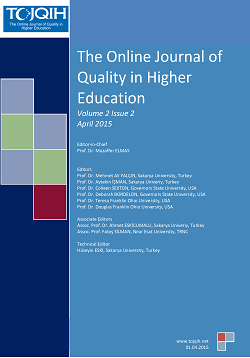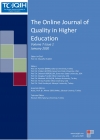TOJQIH - Volume 2 - Issue 2 - April 2015
 ANALYSIS OF THE POST-GRADUATE THESES ON THE SUBJECT OF QUALITY IN THE FIELD OF EDUCATION
ANALYSIS OF THE POST-GRADUATE THESES ON THE SUBJECT OF QUALITY IN THE FIELD OF EDUCATION Associate Professor. Ay├ģ┼Ėe MENT├ä┬░├ģ┼Š TA├ģ┼Š, PhD Student.Tu├ä┼Ėba Cevriye ├āŌĆōZKARAL
Abstract: The present study examines the post-graduate theses the subject field of which are coded as education by YOK (The Council of Higher Education) Head of Journal and Documentation Department based on the concept of quality; according to their publication years, universities, institutes, departments/programs, educational levels, subject fields, and purposes. The study was conducted on a total of 35 theses. Data were obtained via document review. Post-graduate theses on the subject of ├óŌé¼┼ōQuality├óŌé¼┬Ø in the work group were downloaded from the website of YOK Head of Journal and Documentation Department in .pdf format. Then, theses downloaded on the computer were analysed in accordance with sub-purposes. Descriptive analysis method was adopted for data analysis. Data obtained via document review were then arranged according to the themes formed by research questions, and were presented in tables. The findings revealed that most-frequently studied subject matter for postgraduate theses was total quality management.
 AUTHENTIC EVALUATION OF COMPETENCE
AUTHENTIC EVALUATION OF COMPETENCE Antonio Marzano, Iolanda Sara Iannotta
Abstract: Describe competence is a problematic operation that depends on the context and, at school, on the disciplinary character involved. It is believed that the competence is inherent to individual and that this represents his knowledge, experiences and abilities (Le Boterf, 1992). According to social constructivist model, competence refers to the subject intimate mental processes, that allow to break a critical situation and then implement original strategies for solution. McClelland (1973) to whom is attributed the authorship of word, believes that the competence needs motivation , occurs in a context and is achieved by means of appropriate behaviors. Particularly at school, active teaching strategies using the competence to indicate the student├óŌé¼Ōäós ability to independently solve a problem, deploying their knowledge in practice (Pellerey, 2004). To assess the competence you need to design tests of authentic assessment that encourage students to active their knowledge to solve complex tasks.
 COGNITIVE ACTIVATION IN MASS LECTURES THROUGH VOTING SYSTEMS IN THE LECTURE THEATRE
COGNITIVE ACTIVATION IN MASS LECTURES THROUGH VOTING SYSTEMS IN THE LECTURE THEATRE Dr. Stephan H. Schmucker
Abstract: Communication plays an important role in life and especially in education. Nevertheless, most universities have to cope with large numbers of students. Therefore, many introduction courses focus on ex-cathedra teaching. Nowadays, we know that the learning success is limited by such a teaching method. In this paper, I would like to analyse the effects of a new e-learning-tool prepared for large lectures. This new interactive teaching technology allows students to interact with each other even in huge crowded lectures. This paper will compare the learning success of two different teaching methods based on the so-called peer instruction.
 CONTRIBUTION OF MEVLANA EXCHANGE PROGRAM INTO INTERNATIONAL EDUCATION QUALITY-PRODUCTIVITY (SAMPLE OF ADIYAMAN AND RUSSIA UNIVERSITIES)
CONTRIBUTION OF MEVLANA EXCHANGE PROGRAM INTO INTERNATIONAL EDUCATION QUALITY-PRODUCTIVITY (SAMPLE OF ADIYAMAN AND RUSSIA UNIVERSITIES) Asst.Prof. Suat A├ģ┼ŠKIN, Asst.Prof. Murat AYAN
Abstract: Fast and intense developments in communication and transportation technologies in globalizing world affect all sectors, undoubtedly this situation reflects on educational institutions to large extent. High demand for the education felt in each sector reshapes structure of education institutions and society and market together with education. This change showing continuity causes education institutions to differentiate within the framework of obligation of educating more qualified human who is open for global values, contributes into information production and uses information actively and creatively and transforms these into investment. Education quality and productivity of higher education institutions are indicators of development level of any country, thus efforts showed in this direction are of importance. "Mevlana Exchange Program" put into operation by Higher Education Institution (YOK) under the leadership of Turkey in 2013-2014 Academic Year gives students and instructors opportunity of exchanging education and training at international level. This study is to convey information belonging to quantitative and qualitative observation with review of "Mevlana Exchange Program" which was realized by instructors and students coming from Eurasia to Adıyaman University together with instructors and students coming from Adıyaman University to Eurasia.
 LEARNING AND TEACHING IN THE EUROPEAN STRATEGIC NETWORK
LEARNING AND TEACHING IN THE EUROPEAN STRATEGIC NETWORK Juha Kettunen
Abstract: The purpose of this study is to describe the educational development of the European strategic network of higher education institutions. The Consortium on Applied Research and Professional Education was established to promote the collaboration of five universities of applied sciences. The study analyses the learning and teaching modes using blended learning and innovation pedagogy and describes their usability in the strategic network of higher education institutions. The strategic network promotes student and staff exchange, conferences and joint research and development projects. There are also emerging joint educational programmes and ideas to expand the educational programmes to achieve joint degrees. The findings of this study are useful to those who aim to improve collaboration in international networks and strengthen institutional performance.
 PROFESSIONAL LEARNING COMMUNITY IN EDUCATION: LITERATURE REVIEW
PROFESSIONAL LEARNING COMMUNITY IN EDUCATION: LITERATURE REVIEW Xiao Sai1, Saedah Siraj2
Abstract: Professional learning communities enable teachers to collaborate and upgrade their skills to enhance student learning. Nevertheless, professional learning communities vary widely in practice, especially between the developed and developing countries. This review paper discusses the background and development of professional learning communities. It begins with the various definitions of professional learning communities. It then goes into developments and practices in Britain and the United States of America. It then focuses on three models of PLCs: the Senge model, the DuFour model and the Hord model. The similarities and differences in aspects of the three major models are discussed. This paper also covers some differences in practice of PLCs in developed and developing countries, with particular reference to the Asian experience. Finally the role of technology in developing professional learning communities is discussed, and some suggestions for future consideration are given.
 RELIABILITY AND VALIDITY OF THE MULTICULTURAL EDUCATION AND DEMOCRACY PERCEPTION SCALE: A SCALE DEVELOPMENT STUDY
RELIABILITY AND VALIDITY OF THE MULTICULTURAL EDUCATION AND DEMOCRACY PERCEPTION SCALE: A SCALE DEVELOPMENT STUDY Suleyman CELÄ°K, Hasan AYDÄ°N, Cetin TORAMAN
Abstract: The importance of education on social transformation, on modernization, and on realization of the values democracy conveys on individuals which cannot be ignored. As part of equality of opportunity, the role of the realization of the purposes of multicultural education on individuals, that emphasizes people of different cultures benefit from education coequally, will also certainly be assumed by education. To fulfill this duty that needs to be carried out by education, the attitudes, perceptions and interpretations of individuals towards democracy should be known. This required information will ensure that educational activities and it will be carried out more consciously and deliberately. In this vein, the purpose of this study is to develop Turkish Culture specific ├óŌé¼┼ōMulticultural Education and Democracy Perception Scale├óŌé¼┬Ø (MEDPS). It is predicted that this scale will help data collection on multicultural education, and with the results it provides, it will also contribute to the planning of education. In consequence of the exploratory and confirmatory factor analysis, it was determined that MEDPS has a five-factor structure. Through to the Cronbach Alpha internal consistency and reliability coefficient, it proves to be a reliable scale.
 SUPER-EGO AN INHIBITION OF STUDENTS TO SPEAK ENGLISH IN COLLEGES IN KERALA
SUPER-EGO AN INHIBITION OF STUDENTS TO SPEAK ENGLISH IN COLLEGES IN KERALA Vivek Suresh Varghese
Abstract: This paper analyses few factors that leads to inhibition of college students to speak English in Kerala, India. In this paper a field study is done to show how Freud├óŌé¼Ōäós ├óŌé¼┼ōsuperego├óŌé¼┬Ø can lead to inhibition in the mind of the students to speak English in colleges in Kerala. Data collected through field analysis is done to show that spoken English training can overcome the ├óŌé¼┼ōsuperego├óŌé¼┬Ø which creates the inhibition to speak English .In this project, I advocate that if we can overcome negative impact of ├óŌé¼┼ōsuperego├óŌé¼┬Ø then we can overcome the inhibition to speak English. I justify my project with the help of statistics and data collected through random interviews among the college students in Kerala. The aim of the project is to help Government Organizations and Parent Teacher Associations to promote speaking of English in college campuses, so inhibition among students can be removed to speak English.
 THE EFFECTS OF PROFICIENCY LEVEL ON THE COMMUNICATION STRATEGIES AMONG KOSOVAN AND BOSNIANS STUDENTS AT SAKARYA UNIVERSITY
THE EFFECTS OF PROFICIENCY LEVEL ON THE COMMUNICATION STRATEGIES AMONG KOSOVAN AND BOSNIANS STUDENTS AT SAKARYA UNIVERSITY Elvir Shtavica
Abstract: This article reports the communication strategies employed by Kosovan and Bosnian speakers of English as their second language in oral communication tasks outside the classroom. The participants were 18 university students of different departments whose native languages were Albanian and Bosnian. The goal of the study was to determine the effects of English language proficiency (i.e., Elementary and Intermediate levels) on the use of communication strategies while performing the same oral tasks. The data of the oral discussions came from the audio and videorecordings of the tasks. In the current study we applied the taxonomy of communication strategies employed by Tarone (1977; 1981). We analyzed and compared the uses of communication strategies in different occasions. Analysis of the data revealed that the participants dominantly used two types of communication strategies: lower level students used L1 strategies more often and higher level students employed L2 strategies more commonly compared by their lower level peers regardless of the ethnic group.
 THE EXPERIMENT OF UNIVERSITY OF SCIENCE AND TECHNOLOGY IN THE FIELD OF QUALITY ASSURANCE FOR ACADEMIC PERFORMANCE
THE EXPERIMENT OF UNIVERSITY OF SCIENCE AND TECHNOLOGY IN THE FIELD OF QUALITY ASSURANCE FOR ACADEMIC PERFORMANCE Abdullatif Musleh, Ammar Zahary
Abstract: During the last 10 years, University of Science and Technology (UST) in Yemen has developed a special model for quality which has been inspired from the international experiments in the field quality in higher education taking into consideration the privacy and the culture of the zone. This paper presents this model which involves several tools, procedures, quality measures, and Key Performance Indicators (KPIs). The model was developed based on the organizational model so that it involves 4 dimensions of the UST educational system: inputs, processes, outcomes, and feedback. This model is implemented since the academic year 2003/2004 until now and it has subjected to continuous developing and enhancement. As a result of applying this model, a remarkable quality of service has achieved and the UST has grown dramatically in terms of number of students, colleges, programs and international partnerships.
 INVESTIGATING UNIVERSITY STUDENTS├óŌé¼Ōäó LEVEL OF SERVICE QUALITY IN HIGHER EDUCATION
INVESTIGATING UNIVERSITY STUDENTS├óŌé¼Ōäó LEVEL OF SERVICE QUALITY IN HIGHER EDUCATION Ahmet Eskicumal├ä┬▒, Zeynep Demirta├ģ┼Ė, Serhat Arslan, ├ä┬░smail Yarar
Abstract: The present study aimed to investigate whether university students├óŌé¼Ōäó level of service quality in higher education makes a difference or not in their education process in accordance with gender, department, and class level variables. As a data collection tool, ├óŌé¼┼ōHigher Education Service Quality Scale├óŌé¼┬Ø was used. The sample was composed of 239 students studying at Sakarya University. Collected data was analyzed via t-test, and ANOVA. According to findings, there was no significant difference between university students├óŌé¼Ōäó level of service quality in higher education in terms of gender. On the other hand, there was a significant difference in university students├óŌé¼Ōäó level of service quality in higher education in terms of department, and class level.


